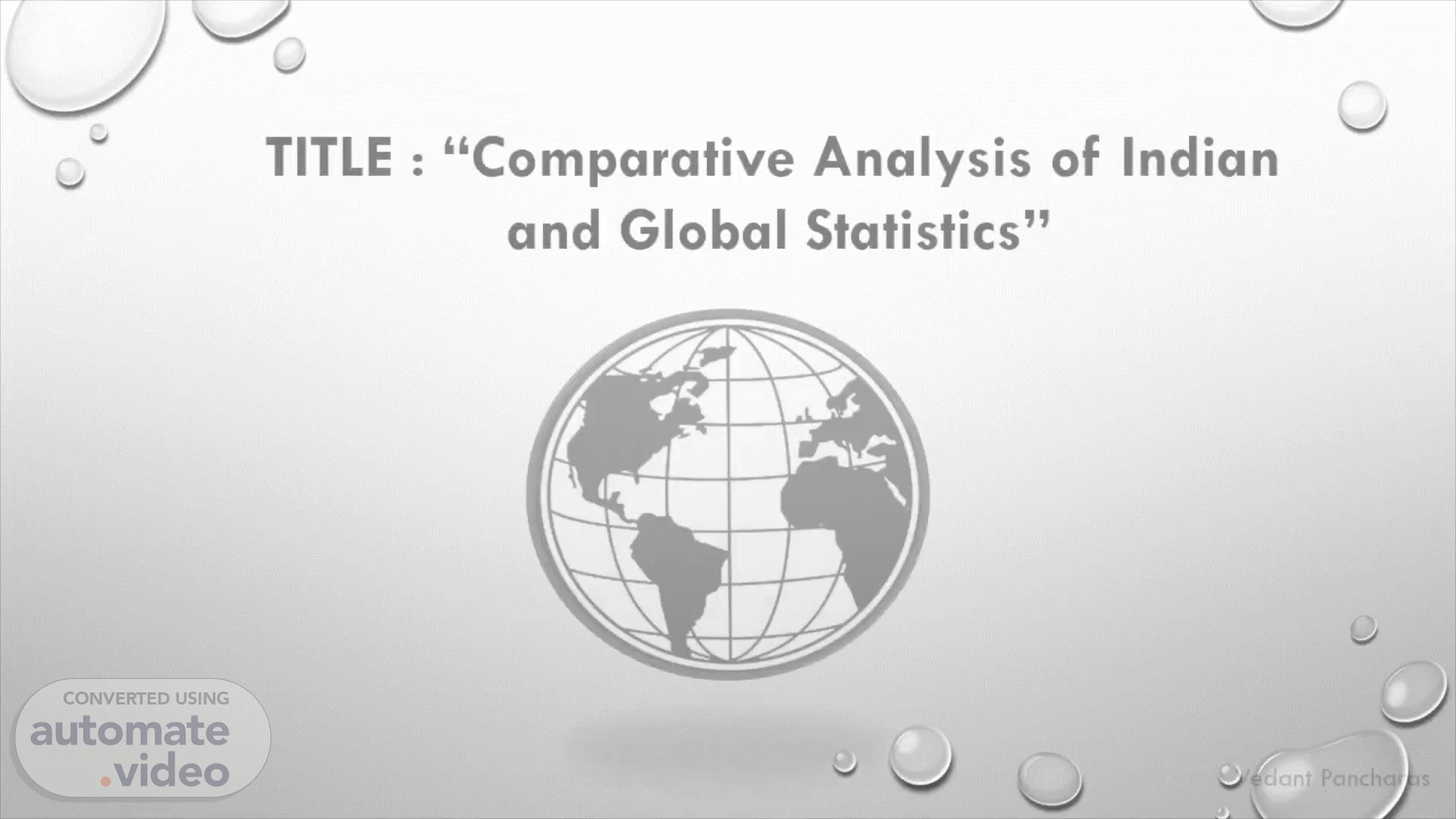
PowerPoint Presentation
Scene 1 (0s)
[Audio] TITLE : “Comparative Analysis of Indian and Global Statistics” Vedant Pancharas.
Scene 2 (9s)
[Audio] INTRODUCTION Statistics are the language of data, providing us with valuable insights and patterns. In this presentation, we embark on a journey to compare and contrast statistical data from India and various parts of the world. By examining both Indian and foreign statistics, we aim to uncover key trends, challenges, and opportunities that transcend borders. Join us as we explore the global landscape and gain a deeper understanding of how data shapes our world. Vedant Pancharas.
Scene 3 (44s)
[Audio] WHAT IS STATISTICS ? Statistics is the study of collecting, analyzing, interpreting, presenting, and organizing data. It is a branch of mathematics that deals with gathering information from numerical data sets. Statistics are used in various fields such as science, economics, social sciences, and business to make informed decisions and predictions based on the available data..
Scene 4 (1m 11s)
[Audio] INDIAN STATISTICIANS 1) India has produced exceptional statisticians who have made their mark both nationally and internationally. 2) Let's explore the contributions of two notable Indian statisticians..
Scene 5 (1m 27s)
[Audio] C.R. RAO ( 1920-PRESENT ) Known for the development of the Rao-Blackwell Theorem and the Cramér-Rao Inequality, key concepts in mathematical statistics. A distinguished Indian statistician, born on September 10, 1920. Pioneered statistical methods in experimental design. Prolific author with numerous publications on statistical topics. Recipient of prestigious awards, including the National Medal of Science. Visual: Photos of C. R. Rao and key concepts he contributed to..
Scene 6 (2m 6s)
[Audio] KANTILAL MARDIA ( 1935-PRESENT ) 1) Specializing in directional statistics, multivariate analysis, geostatistics, statistical bioinformatics and statistical shape analysis, he gained popularity with a series of tests of multivariate normality based measures of multivariate skewness and kurtosis. His work on statistical measures of shape is quite famous too. To raise the standards of Statistics at a global level, he has initiated exchange programs between Leeds and other centres across the globe such as the University of Granada, Spain and the Indian Statistical Institute, Calcutta. He has also penned down several books and conference proceedings..
Scene 7 (2m 50s)
[Audio] FOREIGN STATISTICIANS 1) Foreign statisticians have also left an indelible mark on the global statistical landscape. 2) Let's explore the achievements of two notable foreign statisticians..
Scene 8 (3m 6s)
[Audio] GERTUDE MARY COX (13 JAN 1900 – 17 0CT 1978 ) Main contributionThe founding of the Department of Experimental Statistics at North Carolina State University, the first such department in the nation, which revolutionized the field and brought statistical research into the mainstream. Significance of contributionThis allowed for the engagement of statistics across many fields, including agriculture, energy production, and medicine. It also created more skilled professionals to contribute to the war effort during World War II. ApplicationThe impact of Cox's department allowed for the professional development of many who went on to contribute to the fields of experimental design, bioinformatics, and computational statistics..
Scene 9 (3m 55s)
[Audio] SIR RONALD A. FISHER ( 1890 – 1960 ) A British statistician and geneticist known for revolutionizing statistics. Contributed to experimental design and analysis of variance. Pioneered the concept of the p-value in hypothesistesting. His work remains a cornerstone of statistical methodology. Visual: Photo of Sir Ronald A. Fisher and an illustration of a p-value..
Scene 10 (4m 26s)
[Audio] CONCLUSION In this journey of comparative analysis, we've delved into the world of statistics, exploring both Indian and global data. We've discovered that data transcends borders and offers valuable insights into our interconnected world. Key takeaways from this presentation include:[Highlight key insights or findings from your analysis][Summarize any major trends or patterns identified][Mention any implications or potential areas for further research]As we conclude, it's clear that data is a universal language, allowing us to address global challenges and seize opportunities. We encourage you to continue exploring the power of data and statistics in your endeavors, both on a local and global scale.
Scene 11 (5m 12s)
[Audio] THANK YOU !!!. THANK YOU !!!. Vedant Pancharas.